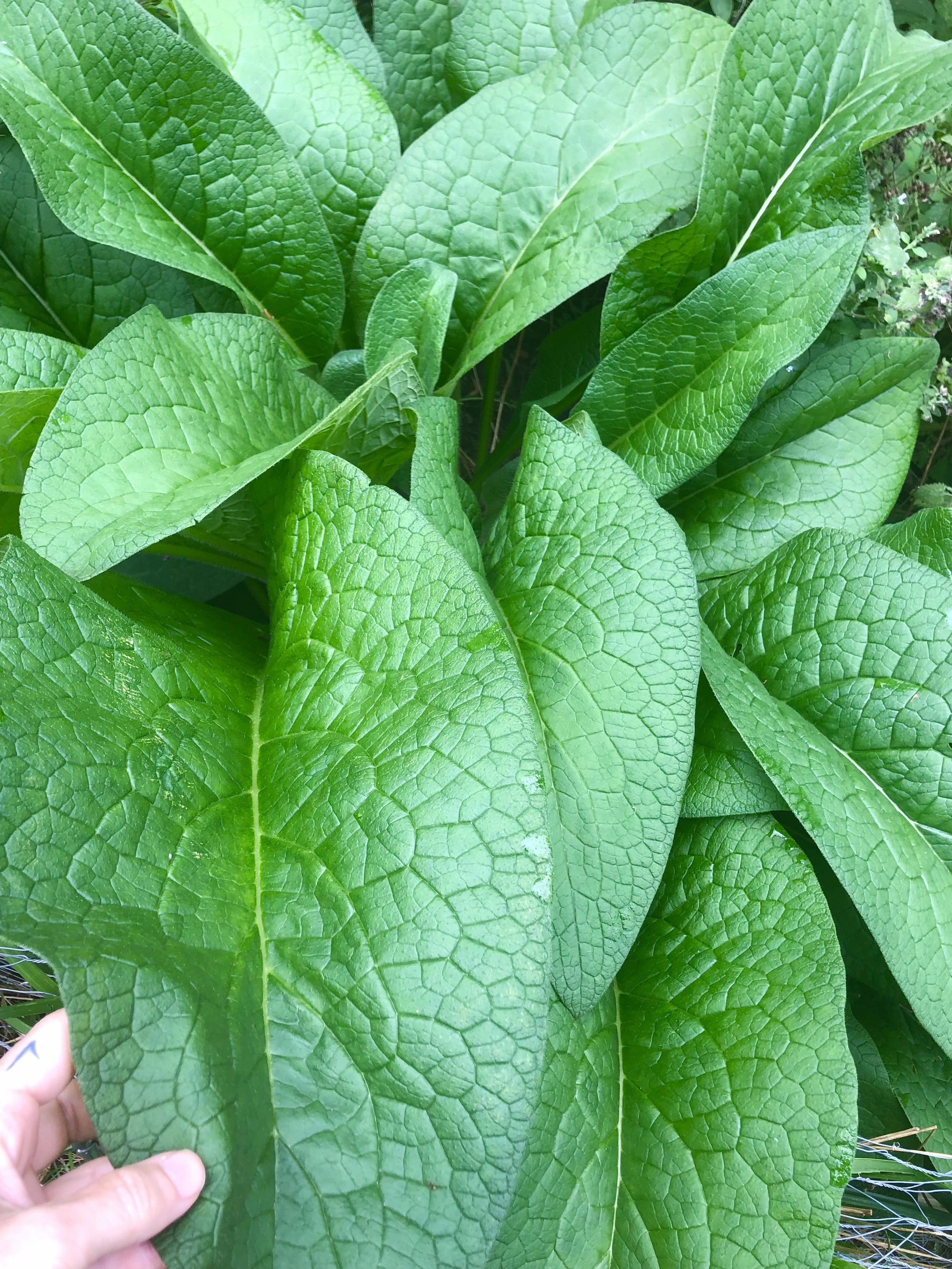
Comfrey
(Symphytum officinale)
Ever giving comfrey

Comfrey (Symphytum officinale)
A Gift from the Earth
Comfrey (Symphytum officinale) is a plant of ancient lineage, known for its deep-reaching roots, broad green leaves, and delicate, bell-shaped flowers. It has been revered by healers, herbalists, and gardeners for centuries. Though now surrounded by controversy due to its pyrrolizidine alkaloids (PAs), comfrey remains one of the most valued plants in traditional herbal medicine and regenerative agriculture.
Comfrey belongs to the Boraginaceae family, which also includes borage and lungwort. The genus Symphytum contains about 35 species, but the two most commonly used are:
Common Comfrey (Symphytum officinale) – The traditional medicinal variety found across Europe and Asia.
Russian Comfrey (Symphytum × uplandicum) – A hybrid of S. officinale and S. asperum, often cultivated for permaculture and composting.
Growth Habits & Identification:
Leaves: Broad, lance-shaped, rough, and hairy.
Flowers: Nodding, tubular, often purple, pink, or cream-colored.
Roots: Thick, black, and mucilaginous when cut.
Reproduction: Primarily through root fragments; difficult to remove once established.
Native Range:
Comfrey is native to Europe and parts of Asia, thriving in moist meadows, riverbanks, and woodland edges. It has since naturalized in North America, particularly in temperate zones where it is grown for both herbal and agricultural purposes.
Comfrey in Folklore and Mythology
Comfrey’s ability to mend and restore made it a plant of restoration and magic in many traditions.
Ancient Greece & Rome: The name Symphytum comes from the Greek symphyo, meaning "to unite or grow together." The Romans used comfrey to bind wounds and broken bones, and it was associated with Pluto, god of the underworld, due to its deep, unseen root system.
Medieval Europe: In medieval herbalism, comfrey was known as "knitbone" or "bone-set" because of its use in traditional external applications. It was also carried by travelers for protection and used in bath rituals for purification and renewal.
Witchcraft and Folk Magic: Some European traditions believed comfrey could "bind" lovers together and was sometimes added to charm bags or brewed into love potions. Travelers carried it for safe journeys, believing it could prevent falls and broken bones.
Herbal Uses of Comfrey
Comfrey’s historical reputation as a powerful healing herb is well documented. Allantoin, one of its key constituents, is known for supporting natural cell regeneration.
Maude Grieve, in A Modern Herbal (1931), provides a detailed botanical and medicinal account of comfrey. She highlights comfrey’s long-standing reputation in traditional medicine, particularly for its use in bone-setting and wound healing, earning it the historical name "Knitbone." She emphasizes its mucilaginous nature, which makes it effective in soothing inflamed tissues and aiding in tissue repair.
For medicinal applications, she describes the use of poultices and compresses, recommending fresh bruised leaves or root preparations applied externally to treat wounds, sprains, and ulcers. She also mentions infusions and decoctions, which were historically taken internally for lung ailments, ulcers, and gastrointestinal issues. However, while these traditional uses were common, modern safety concerns now limit internal consumption.
Modern herbalists continue to value comfrey for its powerful external healing properties, though its internal use is now limited due to safety concerns. Today, comfrey is widely utilized in poultices and compresses, applied topically to support skin healing and tissue repair. Many herbalists incorporate it into salves and ointments, often blending it with calendula, plantain, and St. John’s Wort for added soothing effects. Infused oils made from comfrey leaves are another popular preparation, used to ease muscle strains, bruises, and joint discomfort. Additionally, comfrey has a long history in herbal baths, particularly in traditional postpartum sitz baths, where it is believed to aid perineal healing and reduce inflammation.
Comfrey in Permaculture & Sustainable Gardening
Comfrey is a powerhouse in permaculture, renowned for its ability to act as a dynamic nutrient accumulator. With its deep taproots, it mines essential minerals such as potassium, calcium, and phosphorus from deep within the soil, making these nutrients more accessible to surrounding plants. This quality makes it an invaluable asset for composting, soil enrichment, and regenerative agriculture.
One of its most popular uses is in "chop and drop" mulching, where its broad, nutrient-rich leaves are cut and laid around plants to break down rapidly, feeding the soil with essential minerals. Another favored method is comfrey compost tea, a potent liquid fertilizer made by fermenting comfrey leaves in water, providing an organic, high-nutrient boost for crops.
Additionally, comfrey serves as an excellent pollinator plant, attracting bees, butterflies, and other beneficial insects with its nectar-rich blooms, further enhancing garden biodiversity.
Safety Considerations and FDA Advisory
Comfrey contains pyrrolizidine alkaloids (PAs), which have been linked to liver toxicity in animal studies. Regulatory bodies, including the FDA, Health Canada, and European Medicines Agency, have restricted oral use due to concerns about hepatotoxicity.
Contraindications:
Pregnancy & Breastfeeding – Not recommended.
Liver Conditions – Should be avoided by those with liver concerns.
Deep Open Wounds – Some herbalists advise against use on deep wounds as it can possibly trap an infection with skin regrowth happening too quickly.
Important Note: Herbal preparations should be used responsibly, and individuals should consult a qualified herbalist or healthcare provider before using comfrey.
Comfrey is a plant of paradox—cherished for its medicinal gifts yet burdened by modern concerns. It continues to be a powerful ally for gardeners, herbalists, and those who honor the deep traditions of plant wisdom. Whether enriching soil, drawing pollinators, or finding its way into salves and compresses, comfrey remains a plant of resilience, renewal, and remembrance.
Bibliography
Barlow, Barbara. Comfrey: Past, Present and Future. Self-published, 1997.
Barker, Julian. The Medicinal Flora of Britain and Northwestern Europe. Winter Press, 2001.
Betz, Richard, et al. Comfrey Toxicity and Medicinal Uses. CRC Press, 2002.
Culpeper, Nicholas. Culpeper's Complete Herbal. 1653 (Various Reprints).
Grieves, Maude A Modern Herbal 1932
MacLeod, David. Comfrey in Organic Gardening and Herbal Medicine. Thorsons, 1985.
Newman, Thomas. The Comfrey Report: An Inquiry into the Medicinal and Agricultural Uses of Comfrey. Nutritional Research Publications, 1977.
Thomas, Richard. Comfrey: The Wonder Plant. Rodale Press, 1981.

